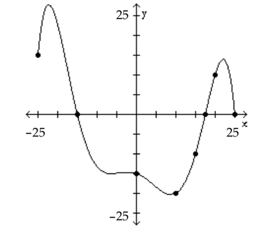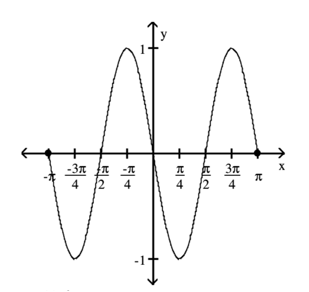Written Assignment 1¶
Question 1¶
1. What linear function, y=f(x) has f(0) = 8 and f(7) = 14 ?
Question 2¶
2. If \(f(t)=2t-t^2+3\) , what is \(\frac{f(t+h)-f(t)}{h}\) ?
Let’s find f(t+h)
And then substitute f(t+h) and f(t) into the equation
Question 3¶
3. Find all solutions to the equation \(-4cosx=-sin^2x+1\). Write your answer in radians in terms of \(\pi\)
we know that \(sin^2x = 1 - cos^2x\), so we can use it in the equation
The equation is true when \(cosx = 0\) or \(cosx = -4\)
- \(x=-4\) is refused as it is not in the domain of \(cosx\) which is \([-1,1]\).
- \(x=0\) is accepted.
So for \(cos(x) = 0\) we have \(x = \frac{\pi}{2} + \pi n\) where \(n\) is an integer.
Question 4¶
4. Sketch the graph of \(y=3^{x+2} +5\). Find the domain, range, and horizontal asymptote. Include the horizontal asymptote in your graph.
- The domain is \((-\infty, \infty)\) as there is no restriction on the value of \(x\).
- The range is \((5, \infty)\). as the term \(3^{x+2}\) is always positive and \(5\) is added to it.
- The line \(y=5\) is the horizontal asymptote (colored blue in the graph below) as \(x\) approaches \(-\infty\) the value of \(y\) approaches \(5\).

Question 5¶
5. Sketch the graph of \(y= log\_ 3(x+2) +5\). Find the domain, range, and vertical asymptote. Include the vertical asymptote in your graph.
- The domain is \((-2, \infty)\) as \(x+2\) must be positive (as it is the argument of the logarithm function).
- The range is \((-\infty, \infty)\) as the logarithm function can take any value.
- The line \(x=-2\) is the vertical asymptote (colored green in the graph below) as \(x\) approaches \(-2\) the value of \(y\) approaches \(-\infty\).
 ¶
¶
Question 6¶
6. Find the domain fo the function \(g(x)= \frac{2x}{x^2-81}\).
The function is defined for all values of \(x ∈ \mathbb{R}\) except when the denominator is zero. So we need to find the values of \(x\) for which \(x^2-81=0\) which is solved for \(x = \pm 9\).
So the domain is \((-\infty, -9) \cup (-9, 9) \cup (9, \infty)\) or \(\mathbb{R} - \{-9, 9\}\).

Question 7¶
7. From the graph below, find what is f(-15) and for what numbers x is f(x)=0.

- \(f(-15) = 0\) as the graph crosses the x-axis at \(x=-15\).
- \(f(x)=0\) when \(x=-15\) and \(x=17\) as the graph crosses the x-axis at \(x=-15\) and \(x=17\).
Question 8¶
8. Determine whether the graph is that of a function. If it is, use the graph to find its domain and range, the intercepts, if any, and any symmetry with respect to the x-axis, the y-axis, or the origin.

- The graph is function as for each value of \(x\) there is only one value of \(y\).
- The domain is \((-\infty, \infty)\) as there is no restriction on the value of \(x\).
- The range is \([-1, 1]\) as the value of \(y\) is always between -1 and 1.
- The graph crosses the x-axis 5 times each period. So the x-intercepts in the period shown in the graph are \(x=-\frac{3}{2}, -\frac{1}{2}, 0, \frac{1}{2}, \frac{3}{2}\).
- Symmetry with respect to the y-axis as the graph is symmetric about the y-axis and origin.
- No symmetry with respect to the x-axis.
Question 9¶
9. Determine whether the function is even, odd, or neither.
a. \(f(x)=4x^3\) b. \(f(x)= \frac{-x^3}{4x^2+3}\) c. \(f(x)=3x^3-5\)
A function is even if \(f(-x)=f(x)\) and odd if \(f(-x)=-f(x)\)..
a. \(f(x)=4x^3\) is odd.
b. \(f(x)= \frac{-x^3}{4x^2+3}\) is odd.
c. \(f(x)=3x^3-5\) is neither.
Question 10¶
10. A cellular phone plan had the following schedule of charges: Basic service, including 100 minutes of calls is $20.00/month; 2nd 100 minutes of calls is $0.075/minute; additional minutes of calls is $0.10/minute.
a. What is the charge for 200 minutes of calls in one month?
- The first 100 minutes are included in the basic service ($20.00/month).
- The next 100 minutes are charged at \(0.075/minute (\)0.075 × 100 = 7.50$).
- Thus, the charge for 200 minutes is \(20.00 + 7.50 = 27.50\).
b. What is the charge for 250 minutes of calls in one month?
- The first 100 minutes are included in the basic service ($20.00/month).
- The next 100 minutes are charged at \(0.075/minute (\)0.075 × 100 = 7.50$).
- The next 50 minutes are charged at \(0.10/minute (\)0.10 × 50 = 5.00$).
- Thus, the charge for 250 minutes is \(20.00 + 7.50 + 5.00 = 32.50\).
c. Construct a function that relates the monthly charge C for x minutes of calls?